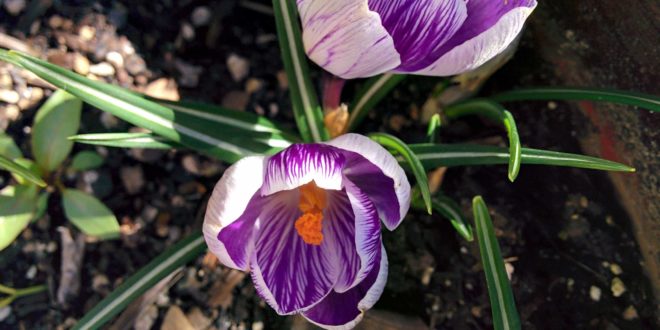We had a very wet February in our Sunnyvale garden. But we still had a lot of flowers: Pea-shrub, orinthogalum, several types of crocus, daffodils, armeria, plum, apricot, flowering plum, viola, cyclamen, english daisy, yarrow, lavendar. On the vegetable side: cilantro, tomatoes, beet, garlic, rhubarb, chile, basil. Lots of spring growth: swartzkopf, mulberry, figs, milkweed, foxglove, caesurium, bleeding-heart, lily-of-the-valley, verbascum, geranium.
On tap for March: hyacinth, squill, fritallary,
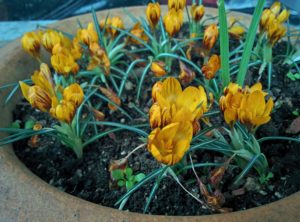 Getting its name from gorgeous, bi-colored orange and near-black blooms that resemble a Monarch Butterfly, this is one of the first to pop up in the early spring. Snow Crocus flower two weeks before their Large Flowering siblings. Great in garden borders and rock gardens. The Monarch crocus has graceful six-petaled, 4” tall flowers that open and close on sunny days, and grass-like foliage with narrow, median silvery stripes. They naturalize readily in well-draining soil and in full to partial sunlight. You’ll need about 9 to 16 corms (bulbs) per square foot for a dense planting.
Getting its name from gorgeous, bi-colored orange and near-black blooms that resemble a Monarch Butterfly, this is one of the first to pop up in the early spring. Snow Crocus flower two weeks before their Large Flowering siblings. Great in garden borders and rock gardens. The Monarch crocus has graceful six-petaled, 4” tall flowers that open and close on sunny days, and grass-like foliage with narrow, median silvery stripes. They naturalize readily in well-draining soil and in full to partial sunlight. You’ll need about 9 to 16 corms (bulbs) per square foot for a dense planting.
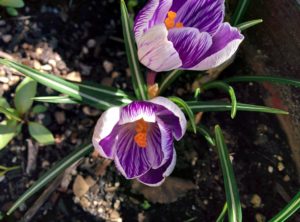 Giant Dutch Crocus “Pickwick’ bears large, cup-like silver-lilac flowers with darker lilac stripes. Vigorous, long-lived and naturalizes easily, this crocus belongs to the Crocus vernus group. Pickwick crocus blooms later in February, for about 3 weeks. The calyx-shaped flowers only open in the sun, they close in rainy weather.
Giant Dutch Crocus “Pickwick’ bears large, cup-like silver-lilac flowers with darker lilac stripes. Vigorous, long-lived and naturalizes easily, this crocus belongs to the Crocus vernus group. Pickwick crocus blooms later in February, for about 3 weeks. The calyx-shaped flowers only open in the sun, they close in rainy weather.
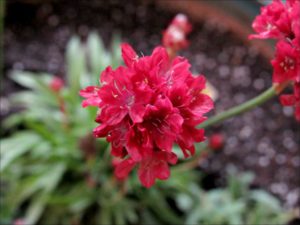 Armeria “Ballerina Red” is a durable perennial for most sunny locations. Compared to A. maritima, False Sea Thrift produces larger flower clusters, broader leaves, stiffer flower stems and stands taller. This selection bears rose-red flowers clusters for many weeks starting im mid-spring. Trim off the spent flowers to encourage repeat blooming. Good rock garden or edging plant. Also excellent in tubs or mixed containers, particularly alpine trough gardens.
Armeria “Ballerina Red” is a durable perennial for most sunny locations. Compared to A. maritima, False Sea Thrift produces larger flower clusters, broader leaves, stiffer flower stems and stands taller. This selection bears rose-red flowers clusters for many weeks starting im mid-spring. Trim off the spent flowers to encourage repeat blooming. Good rock garden or edging plant. Also excellent in tubs or mixed containers, particularly alpine trough gardens.
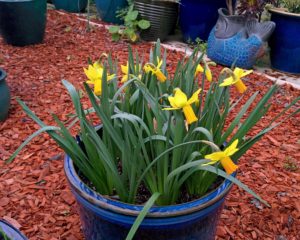 Daffodils bloom in late winter and early spring, breaking the spell of winter with their large blossoms saturated in cheery tones. Narcissus naturally occur in meadows, woodlands, along watercourses, and in rocky outcroppings up to subalpine altitudes. The mainly yellow or white flowers are comprised of 6 petals surrounding a corona. In 2017 we grew two varieties: The variety in the pot has a more orange corona. The variety in the ground of the front yard is larger and is a uniform yellow.
Daffodils bloom in late winter and early spring, breaking the spell of winter with their large blossoms saturated in cheery tones. Narcissus naturally occur in meadows, woodlands, along watercourses, and in rocky outcroppings up to subalpine altitudes. The mainly yellow or white flowers are comprised of 6 petals surrounding a corona. In 2017 we grew two varieties: The variety in the pot has a more orange corona. The variety in the ground of the front yard is larger and is a uniform yellow.
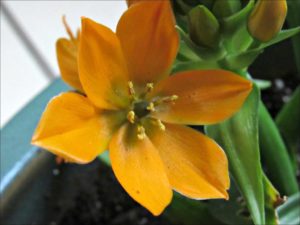 Orinthogalum is a bulb from South Africa. South Africa has a Mediterranean climate like California. Commonly called star of Bethlehem, orange star flower, snake flower or chincherinchee, this bulb is hardy in USDA planting zones 7 through 11, and can be enjoyed as a tender bulb or a potted plant elsewhere. The plant grows up to a foot tall and blooms with clusters of 15 to 20 small six-petaled blossoms on 12 to 15-inch stems in spring. Orange star flower makes an attractive rock garden or woodland plant where they can naturalize in a site that receives full sun.
Orinthogalum is a bulb from South Africa. South Africa has a Mediterranean climate like California. Commonly called star of Bethlehem, orange star flower, snake flower or chincherinchee, this bulb is hardy in USDA planting zones 7 through 11, and can be enjoyed as a tender bulb or a potted plant elsewhere. The plant grows up to a foot tall and blooms with clusters of 15 to 20 small six-petaled blossoms on 12 to 15-inch stems in spring. Orange star flower makes an attractive rock garden or woodland plant where they can naturalize in a site that receives full sun.
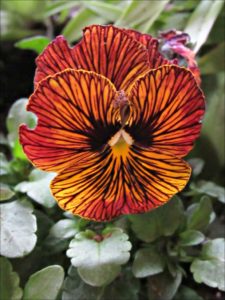
“Tiger Eyes” is a new viola for 2017. 1” bright golden yellow flowers have black perfectly clear radiating veins around a central black eye. 6”-8” tall and 10” spread. Very Fragrant. I got them this year for Marie for Valentine’s Day.
Some Viola species are perennial plants, some are annual plants, and a few are small shrubs. A large number of species, varieties and cultivars are grown in gardens for their ornamental flowers.
In horticulture the term “pansy” is normally used for those multi-coloured, large-flowered cultivars which are raised annually or biennially from seed and used extensively in bedding. The terms “viola” and “violet” are normally reserved for small-flowered annuals or perennials, including the species. Hardy in U.S. Department of Agriculture plant hardiness zones 3 through 9, violas and pansies are a colorful addition to your home when grown as a houseplant.
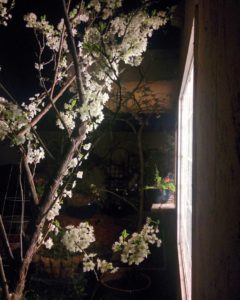 Night and Day. All three of our plum trees are flowering. They are all in large pots. We have a Weeping Santa Rosa, a regular Santa Rosa, and a 4-in-1 ultra-dwarf. I gave each of them a fertilizer stake and they have had all the rain they could want. All produce fruit.
Night and Day. All three of our plum trees are flowering. They are all in large pots. We have a Weeping Santa Rosa, a regular Santa Rosa, and a 4-in-1 ultra-dwarf. I gave each of them a fertilizer stake and they have had all the rain they could want. All produce fruit. 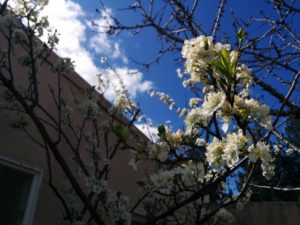
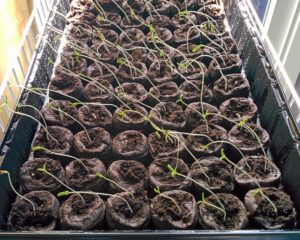 Our Tomato seedlings are doing well. We cut back this year and only planted 9 varieties. We have about 50 plants. I have transplanted the seedlings from peat pots into larger pots. I am still keeping them indoors as the night-time temperature still often drops below 40 degrees (which is not good for tomatoes).
Our Tomato seedlings are doing well. We cut back this year and only planted 9 varieties. We have about 50 plants. I have transplanted the seedlings from peat pots into larger pots. I am still keeping them indoors as the night-time temperature still often drops below 40 degrees (which is not good for tomatoes).
My Red Savina chile pepper plant has survived the winter indoors and I have high hopes for very hot peppers this year.
New rhubarb leaves have appeared. I will be repotting.
